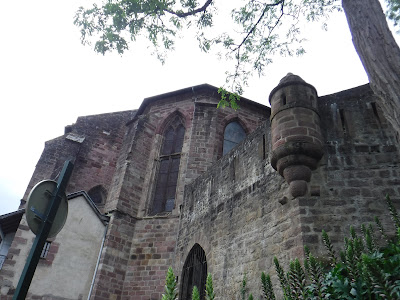Not everyone walks the entire route. Initially, I had considered starting from Pamplona, Spain, as it is more convenient to reach. My plan was to walk as much as I could and then skip the middle section, only walking the last 100km from Sarria to Santiago de Compostela to qualify for the certificate. Lilian suggested starting from the beginning, and after giving it some thought, I agreed that it made the most sense. (Once I started walking, I had a change of heart and decided that I didn't want to skip any part of the route. I was determined to walk as much as I could with the time I had available. I made a decision to come back next year and continue my journey from where I left off, until I reach the end. This way, I would have the opportunity to experience the entire Camino and fully immerse myself in the pilgrimage).
I flew to Madrid and met up with Lilian. We spent two days in the city, exploring and recovering from jetlag before embarking on our Camino.
From Madrid, we took a train to Pamplona and then caught a bus to Saint-Jean-Pied-de-Port.
We were advised to make hostel reservations in Saint-Jean-Pied-de-Port, as it tends to be crowded with people starting their journey there.
During the train ride, I struck up a conversation with two locals who were seated across from us. They spoke English—a young girl and a middle-aged man. The man informed me that the bus station in Pamplona was just a 10-minute walk away. However, upon arriving in Pamplona, he kindly offered to take us in a taxi to the bus station, as it was a 5-minute ride. Unfortunately, when we reached the bus station to purchase our tickets, we were informed that the bus was already full and had left. We had no other option but to take a taxi, which cost us 120 euros. Luckily, another pilgrim joined us, so the three of us shared the taxi, making the cost more manageable in the end.
After a 1.5-hour ride, we finally arrived in Saint-Jean-Pied-de-Port.
The most important task in Saint-Jean-Pied-de-Port is to visit the pilgrim's office (located at Rue de la Citadelle, no. 39) to obtain a pilgrim passport. This passport serves as your identification (or "Credenciales" in Spanish) to prove that you are a pilgrim. It allows you to stay in pilgrim hostels (albergues) along the Camino and collect stamps along the way, serving as evidence of your journey to obtain the certificate.
At the pilgrim's office, you will also receive a list of albergues along the route, along with basic information about each place such as phone numbers and the number of beds available. They will provide you with a Camino map that shows the stages and profiles of the suggested routes.
Saint-Jean is a hub for pilgrims, offering everything you need for your pilgrimage, including walking sticks, t-shirts, scallop shells, maps, and food and drinks.
The town itself is charming, and you don't need much time to explore and gather the necessary items. We visited a grocery store to buy ingredients for a meal at the albergue, as well as had lunch at a restaurant. We later shared our food and wine with other pilgrims. In the photos below, you can see moments from our arrival in town, checking into our albergue, and enjoying a meal with fellow pilgrims: Rose, a 28-year-old Korean girl who recently quit her job to do the Camino, and two French men (a tenant with his landlord, who were doing the Camino together and didn't speak English). Rose, being outgoing and bubbly, cooked a delicious chicken and pork dish and communicated with the French men using Google Translate and laughs quickly. The shared meal became a delightful moment, filled with delicious food, laughter, and the joy of forging connections on the Camino.















No comments:
Post a Comment